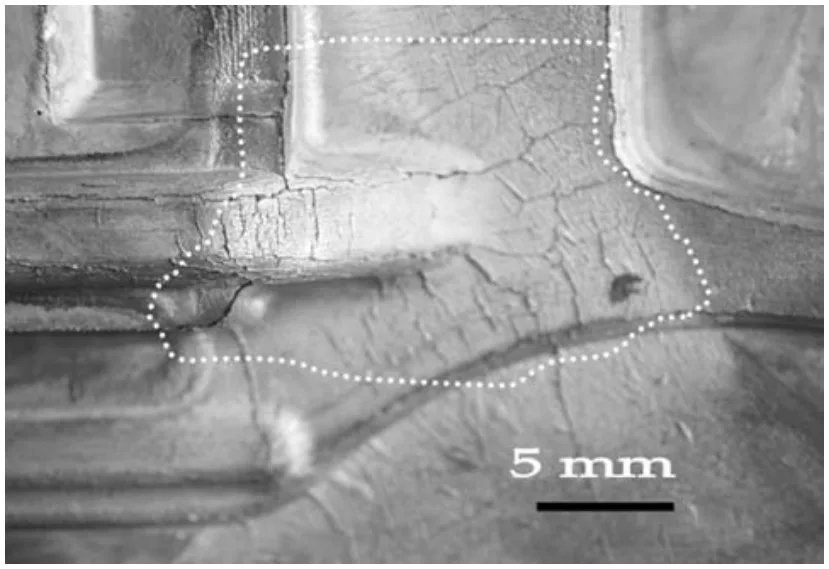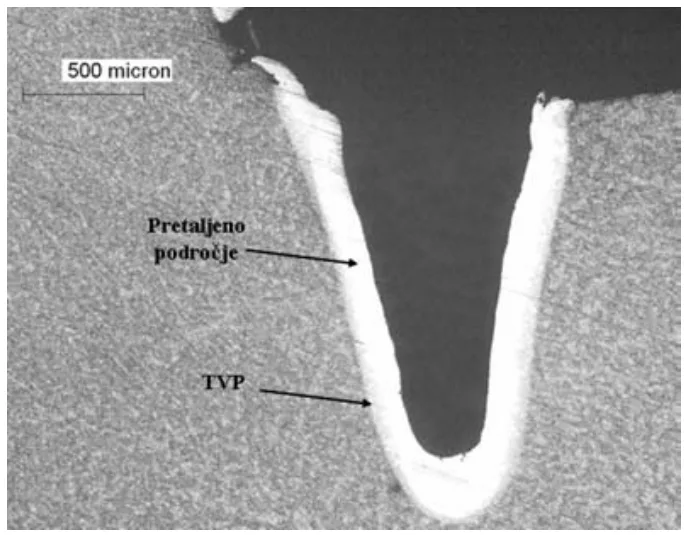This introduction paper is based on the paper "Laser repair welding of thermal cracks on Aluminium die casting dies" published by "Materials and Technologies".

1. Overview:
- Title: Laser repair welding of thermal cracks on Aluminium die casting dies
- Author: Matej Pleterski, Janez Tušek, Ladislav Kosec, Damjan Klobčar, Mitja Muhič, Tadej Muhič
- Year of publication: 2008
- Journal/academic society of publication: Materials and Technologies (MTAEC9, 42(5)211(2008))
- Keywords: die casting, dies, cracks, repairing, laser welding, aluminium
2. Abstract:
Repair welding of damaged and worn-out tools is a measure, which can increase productivity and lower production costs to a great extent. For this purpose, laser technology has recently been used with major benefits such as localized heating effect, narrow heat effected zone and negligible undercuts. In the die-casting process, dies are submitted to a complex thermo mechanical stressing and high stresses on the surfaces of dies are induced. That may lead to thermal fatigue cracking. In this paper, the technology of thermal cracks repair (grooving, welding) with pulsed Nd:YAG laser is described. A micro-hardness analysis of areas surrounding cracks, grooves and welds has been performed, also. The test results suggest that it is relatively fast and easy to eliminate the fatigue area surrounding the cracks, and with proper welding to reestablish the tool operability.
3. Introduction:
Laser welding is an established industrial application, with laser repair welding and cladding being a newer technology increasingly used for tool maintenance in industries like foundry and toolmaking. Die casting dies, typically made from high-quality hot-work steels (e.g., requiring HRc ≈ 45 for non-ferrous metals), are prone to thermal fatigue cracking due to complex thermomechanical stresses during operation (Figure 1). While traditional repair methods include grinding, milling, and arc welding, laser technology offers the capability to both groove out these cracks and subsequently weld them, providing an alternative repair solution.
4. Summary of the study:
Background of the research topic:
Die casting dies are subjected to complex thermomechanical stresses during their operational life, which often leads to the formation of thermal fatigue cracks on their surfaces. The repair of these cracks is crucial for maintaining the quality of the cast parts and extending the service life of the dies. Laser technology presents several advantages for tool repair, including localized heat input, a narrow heat-affected zone (HAZ), and minimal distortion or undercuts.
Status of previous research:
Previous studies have explored various aspects of die repair. Sun et al.1,2 investigated the re-melting of cracks without filler material, focusing on fatigue and tensile properties. Vedani et al.3 examined microstructural developments and metallurgical issues in the repair welding of tool steels. Other researchers4,5 have explored laser repair welding in different applications, with some suggesting its superiority over conventional methods like arc welding in specific contexts, such as ship plate repair, due to reduced repair times and costs.
Purpose of the study:
The primary purpose of this study was to present and evaluate a laser-based technology for repairing thermal cracks on aluminium die casting dies. This involved using a pulsed Nd:YAG laser for both grooving out the cracks and subsequent welding. The study aimed to analyze the micro-hardness of the areas surrounding the original cracks, the laser-machined grooves, and the resulting welds to assess the effectiveness of the repair in restoring tool operability.
Core study:
The core of the study involved an experimental investigation into the laser repair process. This included:
- Selection of a worn aluminium die casting die made of 1.2343 (X38CrMoV5-1) steel exhibiting thermal cracks.
- Systematic application of laser grooving to remove the cracked material.
- Laser welding of the grooved area using a suitable filler material (Uddeholm G3).
- Detailed micro-hardness testing and microstructural characterization (using SEM) of the die material at various stages: in the vicinity of the original crack, after grooving, and after welding.
5. Research Methodology
Research Design:
The research was designed as an experimental study. A side core from a used die casting tool for an automotive seatbelt reel, made of 1.2343 (X38CrMoV5-1) steel and exhibiting a thermal crack, was selected as the test specimen (Figure 2). The specimen was sectioned at different stages of the repair process (initial state, after laser grooving, and after laser welding) to facilitate analysis. Microhardness measurements and Scanning Electron Microscopy (SEM) were employed to evaluate the material's condition.
Data Collection and Analysis Methods:
- Base Material: The die was made of 1.2343 (X38CrMoV5-1) tool steel, hardened to 45 ± 2 HRc (equivalent to 450 ± 30 HV).
- Laser System: A pulsed Nd:YAG laser with a power of 120 W was used for the grooving process.
- Filler Material: Uddeholm G3 wire with a diameter of 0.5 mm was used for the welding process.
- Shielding Gas: Argon (Ar) with a purity of 99.9996% was used as a shielding gas during both grooving and welding.
- Laser Parameters: Specific parameters for laser grooving and welding, including pulse frequency, pulse duration, average power, pulse energy, and focal length, were defined and are detailed in Table 1 of the original paper. For grooving, a high energy density (greater than 1010 W/m²) was required to vaporize and remove the steel.
- Microhardness Testing: Vickers microhardness tests were conducted with a 100 g load (0.981 N force). Measurements were taken at depths of 0.3 mm, 0.6 mm, and 1 mm from the surface, with results at 1 mm depth primarily presented for clarity.
- Microstructural Analysis: Prepared macro sections were examined, and microstructural details were analyzed using SEM (SEI).
Research Topics and Scope:
The study focused on:
- The feasibility and effectiveness of using a pulsed Nd:YAG laser for both the removal (grooving) of thermal cracks and the subsequent repair welding of aluminium die casting dies.
- The characterization of hardness profiles and microstructures in the base material, the heat-affected zone (HAZ), the laser-grooved regions, and the laser-welded regions.
- The investigation was specific to 1.2343 tool steel and Uddeholm G3 filler material under defined laser processing conditions.
6. Key Results:
Key Results:
- Initial Crack Analysis: The microhardness around the existing thermal crack (Figure 3) was found to be approximately 200 HV higher than the nominal hardness of the tool steel (Figure 4). This was uncharacteristic for thermal fatigue cracks (where hardness usually drops) and suggested that the die might have undergone a previous repair attempt.
- Laser Grooving: Laser grooving was successfully employed to remove the cracked material. A macro section of the groove is shown in Figure 5. A distinct, narrow (~0.2 mm wide) remelted and rehardened zone was observed along the edge of the groove. This zone exhibited significantly increased hardness, up to 300 HV higher than the base material (Figure 6), attributed to the high energy density of the laser during grooving and the rapid self-quenching effect.
- Microstructure of Grooved Area: The microstructure at the groove (Figure 7) revealed distinct zones: A-base material, B-HAZ, C-solidification line, D-cellular dendrite area, and E-axial dendrite area.
- Laser Welding: The grooved area was subsequently repair welded using Uddeholm G3 filler material. A macro section of the welded groove is shown in Figure 8. The hardness profile across the weld was analyzed (Figure 9).
- Weld Microstructure and Hardness: The microstructure at the weld boundary (Figure 10) consisted of A-base material, B-HAZ, C-dendrite area, and D-layers indicating the heat effect of multi-pass groove filling. This transition zone also exhibited high hardness. The microstructure in the center of the weld (Figure 11) was a fine dendritic (martensitic) structure, and its hardness was found to be slightly higher than that of the base material.
- Overall Repair Effectiveness: The study concluded that by carefully selecting laser parameters and an appropriate filler material (with lower C and higher Cr, Mo content than the base material for laser welding), it is possible to repair cracked dies effectively. The process allows for the removal of fatigued material and the creation of a weld with hardness values close to that of the original die material, thereby re-establishing tool operability.
Figure Name List:


- Figure 1: Imprints of cracks on a cast, as a result of thermal cracking
- Figure 2: Test specimen with marked cuts
- Figure 3: Macro section of a thermal crack
- Figure 4: Location of measurements (a) and the hardness profile in direction perpendicular to the crack (b)
- Figure 5: Macro section of the groove
- Figure 6: Hardness profile in the direction perpendicular to the groove
- Figure 7: Image of microstructure at the groove: A-base material; B-HAZ; C-solidification line; D-cellular dendrite area; E-axial dendrite area; SEM (SEI)
- Figure 8: Macro section of the welded groove
- Figure 9: Hardness profile across the weld
- Figure 10: Microstructure at the weld boundary: A-base material; B-HAZ; C- dendrite area; D-layers of heat effect of multi-pass groove filling; SEM (SEI)
- Figure 11: Microstructure in the weld; Fine dendritic microstructure; SEM (SEI)
7. Conclusion:
The research results show that with laser technology it is possible to repair a cracked tool relatively quickly and easily. With the appropriate parameters of the laser beam, it is possible to groove the crack and thus remove the fatigued material around the crack. Although a narrow remelted zone appears in the thus prepared groove, which hardens strongly, it is possible, by setting the appropriate laser parameters and choosing the right filler material, to weld the tool so that the hardness of the weld is close to the hardness of the base material.
8. References:
- [1 Y. Sun, S. Hanaki, M. Yamashita, H. Uchida, H. Tsujii: Vacuum 73 (2004), 655-660]
- [2 Y. Sun, H. Sunada, N. Tsujii: ISIJ International, 41 (2001) 9, 1006-1009]
- [3 M. Vedani: Journal of Materials Science (2004), 241-249]
- [4 E. Capello, D. Colombo, B. Previtali: Journal of Materials Pro-cessing Technology 164-165 (2005), 990-1000]
- [5 P. M. Brown, G. Shannon, W. Deans, J. Berd: Weld World (1999), 33]
- [6 F. Kosel, L. Kosec: Mechanical Engineering Journal 29, (1983), E1-E8]
9. Copyright:
- This material is a paper by "Matej Pleterski, Janez Tušek, Ladislav Kosec, Damjan Klobčar, Mitja Muhič, Tadej Muhič". Based on "Laser repair welding of thermal cracks on Aluminium die casting dies".
- Source of the paper: https://www.researchgate.net/publication/283814470
- This material is summarized based on the above paper, and unauthorized use for commercial purposes is prohibited.
- Copyright © 2025 CASTMAN. All rights reserved.